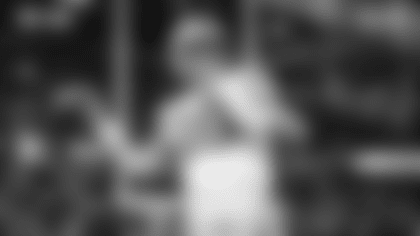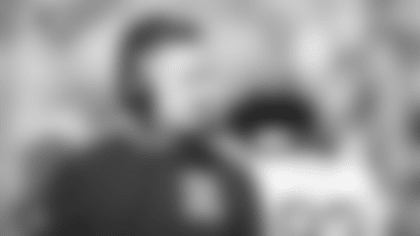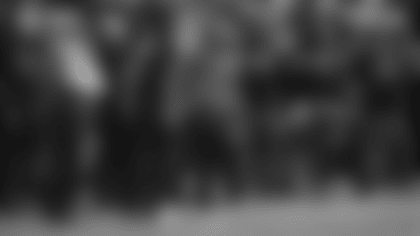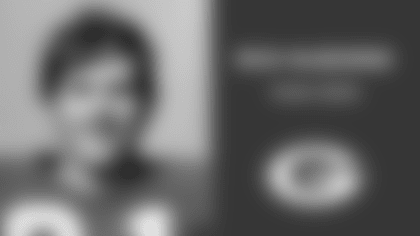The Packers evaluated Abdul Hodge (right) & Johnny Jolly at the 2006 Combine, later selecting them in the third and sixth rounds, respectively.
*The Green Bay Packers have numerous representatives involved in the National Scouting Combine in various ways, from scouting players to performing medical evaluations to videotaping workouts.
Packers.com takes a look at the team's involvement, and at the process of getting ready for and working at the Combine, in a three-part series.*
The annual National Scouting Combine in Indianapolis is a key part of the Packers' preparation for the NFL Draft in April.
But equally important, if not moreso, is all the preparation the team's scouting and personnel staffs do to get ready to go to the Combine, allowing them to get the most out of a whirlwind week at the RCA Dome and its surrounding hotels.
The annual Combine brings in 300-plus draft-eligible players for a series of medical tests, workouts and interviews in front of essentially every NFL team. All the information gathered helps teams, in part, finalize their draft boards on which they rank players according to their potential value in a given round of the draft.
But it's important to note that the Combine, despite the heightened media attention it has received in recent years, is not the be-all and end-all of the scouting process. If it were, there'd be little value in putting in all the legwork that leads up to it.
"It's very big for us, but it's just a piece of the pie," Packers college scouting coordinator Danny Mock said. "We try to keep it low-key, very business-like for us. We know what needs to be done."
That's because of the work that's already been done before anyone from the organization sets foot in Indy, from the on-site scouting of college players during practices and games all fall to the more up-close look at top prospects during the series of college all-star games that run through December and January.
When all of that concludes, all the scouts, coaches and personnel staff begin a series of pre-draft meetings that take place every day for roughly three weeks leading up to the Combine. During that time, draft prospects are discussed at length, position by position, and some initial evaluations and rankings are established.
"We'll have our board semi-set as far as our first pass through for how we have guys rated," said Mock, describing a process every NFL team goes through at this time of year. "There will be a lot of guys up there with question marks. Some of them we won't have verified heights and weights or a 40 speed.
"Guys at Indy that have those questions, those will be answered right away."
And so, in Indianapolis, the process of filling in those gaps begins. Mock noted that it's not uncommon for a college football roster's heights and weights on players to be inaccurate or outdated, so if those vitals aren't gathered during one of the all-star trips, or if there are any uncertainties, those are verified.
The staff also must send to Indianapolis, ahead of time, the list of players it wishes to interview during the Combine, with each team allowed a maximum of 60 arranged meetings.
That may sound like a lot when each team is only going to draft perhaps six to 10 players in late April, but there's no way of knowing how the draft is going to fall, so it's important to gather as much information and get to know as many players as possible.
There are also several players at the Combine who won't get drafted and will be signed as "street" free agents in the first day or two after the draft, and the interviews provide a chance to make an initial contact and get to know more about them. In addition, it reduces the workload in March, when other potential post-draft signees who weren't at the Combine are brought in for individual visits. Some players who were at the Combine but whom the team wants further physical evaluations on will be brought in then, too.
During that same period in March, the team's college scouts are back on various campuses for those schools' "pro days," getting yet another look at players, some of whom may have skipped parts of the Combine workout, such as the 40-yard dash or position drills, because of injury or other reasons.
{sportsad300}But back to the Combine itself, all the members of the scouting and coaching staffs will have their responsibilities in Indy.
For the scouts, they will focus on the players they scouted in their geographic area in the fall, reinforcing what they evaluated in person and on film, and getting to know the players they scouted even more thoroughly.
The position coaches will pay attention to prospects at those individual positions, obviously, and unlike the scouts who were on the road throughout the college football season, will be seeing these players work out live for the first time.
"They can watch film all they want, but until the evaluators can see a guy live and move around athletically and everything, that's like your missing piece right there," Mock said.
"It's similar to a school workout, but they're just doing it all in a group, one after another, and that's good. You'll have, say, 25 linebackers all doing the same drills and you can see who's a little bit stiffer in the hips or who's not as quick off the ball, that type of thing."
Throughout the Combine, the team has prospects it is focusing on more than others, because it's nearly impossible to fully evaluate all 300-plus players who attend. But the staff doesn't necessarily rule out prospects, because there's always the chance a player who has stayed under the radar could start to emerge.
"We always leave the door open with guys that aren't on our board or not very high on our board to see how they do down there and how they come across," Mock said.
"For the guys our college scouts already know, the biggest thing is the Combine will throw up flags that you'll want to check out further on the campuses or by watching more tape."
That's a lot of what happens in March, reviewing both game film and Combine film on players, plus the campus pro days and player visits. Much like the preparation for the Combine, there's still plenty of pre-draft work to conduct after the Combine is over.
Ultimately all the information gathered is then processed in a final two weeks of meetings in April, which leads to adjustments on the draft board until it's done and ready for the two-day draft April 28-29.
At that time, the Combine will seem like it took place ages ago. The evaluations of players are so ongoing, and so thorough, that for the Combine to make-or-break a player happens far less frequently than it may seem.
But the 4 1/2 days in Indianapolis are a valuable part of the process for every team, and it is given its due, to be sure.
"So much is said about a guy who can raise his stock, and this and that, but it's really just a piece of the pie," Mock said. "The main thing is what happens in that meeting room, evaluating the players - the scouts in the fall as a group, and where they put them on the board as far as playing football and seeing them on film.
"Then you factor in the testing part and the character part that comes from the workouts, the interviews, the background checks and all of that from the Combine. It all factors in."














